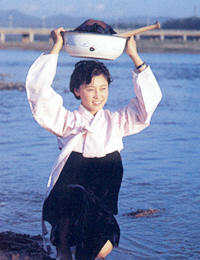 The Korean ethnic minority in China has a population of 1,920,597 (as of 1990), mainly living in the Yanbian Korean Autonomous Prefecture in Jilin Province. Some are widely distributed over Jilin, Heilongjiang, Liaoning provinces and the Inner Mongolian Autonomous Region.
The Korean ethnic minority in China has a population of 1,920,597 (as of 1990), mainly living in the Yanbian Korean Autonomous Prefecture in Jilin Province. Some are widely distributed over Jilin, Heilongjiang, Liaoning provinces and the Inner Mongolian Autonomous Region.
The Koreans have their own spoken and written language and a fairly developed culture and education. Their language, divided into six dialects, is thought to belong to the Altaic family. They also use the Chinese language and characters.
The ancestors of the Korean minority in China emigrated from the Korean Peninsula. The immigration began in the latter part of the 17th century, but did not occur in sizable numbers until the 19th century. They first move to avoid the oppressive feudal landlords in Korea, but later mainly to avoid the famine of 1869 and the warfare launched by the Japanese in early 20th century. These people settled in northeastern China and gradually developed into one of the minorities in China.
The Korean people are mainly engaged in agriculture. They are especially good at growing paddy rice in the frigid region where they live. The Yanbian area, where most of the Koreans live, is the Home for Paddies in northeastern China.
The Yanbian Korean Autonomous Prefecture is a beautiful, majestic land of high mountains and deep valleys. The land rises to 2,744 meters above sea level to the highest peak of the Changbai Mountains -- White Head Summit. The area is one of China's major sources of timber and forest products, including the Three Treasures in the Northeast -- ginseng, marten pelts and deer antlers. It is also a habitat for many wild animals, including tigers.
The early Korean people practiced totemism and ancestor worship. Now, there is no uniform religion for this minority. Some believe in Buddhism or Confucianism, and a small number believe in Christianity or Catholicism.
Basically, the Korean minority celebrates the same festivals as the Han people, which including the Lunar New Year, the Mid-autumn Festival, the Qingming Festival, etc. The Korean people also have three famous household festivals, namely, A baby's First Birthday, the Huajia Festival and the Huihun Festival.
To celebrate a baby's first birthday, many guests would be invited to attend a dinner party. The Huajia Festival is the sixtieth birthday and the Huihun Festival is the sixtieth wedding anniversary.
The Korean people are especially good at singing and dancing. They sing and dance not only during the festivals, but also in the leisure time and during breaks in work. The Korean dances are graceful and elegant, a harmonious combination of strength and flexibility. The famous folk dances include the Tambourin Dance, Fan Dance, Carrying Water Dance, Sword Dance, Dance of Happy Farmers, etc.
The Koreas like playing football, wrestling, skating, springboard and swinging. The women are fond of playing gangplank and swinging. The men like completing in strength skills or wrestling. Football is especially popular among the Korean men and Yanbian area has the reputation of Land of Footballs.
